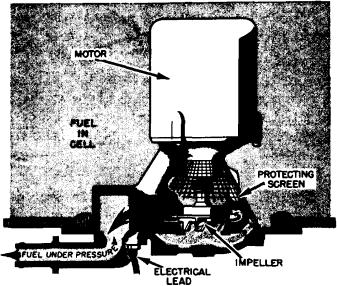
Auxiliary fuel pumps or booster pumps are
External Fuel Transfer
required in every pressure feed system. They are
needed to supply fuel pressure for starting the
External fuel tank pressurization and transfer
engine and to supply fuel to the primer system.
is accomplished with regulated engine bleed air.
They are also used as an emergency pump in case
An external tank pressure regulator maintains 15
of failure of the engine-driven unit.
to 18 psi air pressure to each of the external tanks.
The submerged boost pump is essentially an
Once the tank is pressurized, fuel then transfers
integral unit composed of a centrifugal pump and
through the refuel/transfer shutoff valve into
an electric motor. A screen is provided to protect
the refueling manifold. External fuel is then
the pump from foreign matter. A submerged
transferred to any of the fuel tanks that will
accept the fuel. The refuel/transfer valve will close
boost pump is shown in figure 4-9.
automatically when the external tank is empty.
Strainers.-- Strainers are installed in the tank
The external tank air pressure regulator closes
outlets and frequently in the tank filler necks.
when there is weight on the wheels or when the
These strainers are of fairly coarse mesh and
in-flight refueling probe is extended. This will
prevent the tanks from being pressurized while the
prevent only the larger particles from entering the
fuel system. Other strainers are provided in the
aircraft is on the ground, during an arrested
fuel inlets and in the fuel lines themselves. The
landing, or during in-flight refueling.
latter are fine-mesh strainers.
External Fuel Tank Jettison
FUEL QUANTITY INDICATORS.-- Quan-
The external fuel tanks can be selectively
tity-indicating units will vary. A fuel counter or
indicator, mounted on the instrument panel, is
jettisoned or all jettisoned at one time, such as
electrically connected to a flowmeter installed in
during an emergency situation. The external
the fuel line to the engine. The fuel counter is
tank to pylon fuel/air coupling valves will
s i m i l a r in appearance to an automobile
automatically close the fuel transfer and air
pressurization tubes once the tanks are jettisoned.
speedometer. When the aircraft is serviced with
fuel, the counter is automatically set to the total
number of pounds of fuel in all tanks. As fuel
Fuel Tank Components
passes through the measuring element of the
flowmeter, it sends electrical impulses to the fuel
Common fuel tank parts include pumps,
strainers, fuel quantity indicators, valves to
counter. These impulses actuate the fuel counter
mechanism in such a way that the number of
control fuel level or routing, and vents and drains.
These parts provide capabilities for fueling,
defueling, and fuel system management.
PUMPS.-- The airframe fuel system uses
transfer pumps and boost pumps to deliver a
continuous supply of fuel to the engine(s) under
all operating conditions.
Transfer Pumps.-- Fuel transfer pumps are
installed in the fuel system to pump fuel from the
various tanks of the aircraft to the main or sump
tank. There are several different types of transfer
pumps; common ones are electrically driven or
an ejector-type motive-flow pump. See figure 4-8.
Since the type of pump may differ from one air-
craft model to another, the applicable main-
tenance instruction manual should be consulted
for proper identification and maintenance.
Boost Pumps.-- All Navy fixed-wing aircraft
use pressure feed fuel systems. The basic source
Figure 4-9.-Submerged boost pump.
for this pressure is the engine-driven pump.
4-15

